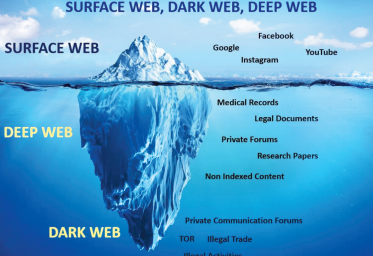The dark web includes websites not indexed by search engines, allowing for potential anonymity. The dark web is not the same thing as the deep web. Frankly, the dark web is only a tiny fraction of the deep web, which contains mostly benign sites, such as password-protected E-mail accounts, certain parts of paid subscription services like Netflix, and sites accessible only through online forms. Both are highly effective sources of mass media.
The identities of dark web site visitors are hidden by anonymising software on their computers, which dark web networks require for access. Each dark web site URL ends with a domain-name extension associated with the software necessary for its use (e.g., ‘.onion’ for The Onion Router ‘Tor’ network). While all software used to enter the dark web operates differently, the common principle is that encrypted data is rerouted through the computers of other users running the same programme, thereby disguising the data’s origin and destination.
The earliest form of the modern dark web arose in March 2000 when Irish student Ian Clarke developed and released Freenet, which offers anonymous online communication via a decentralised network of Freenet’s users. However, the software that popularised the dark web is The Onion Router (Tor), which launched on September 20, 2002. The Naval Research Laboratory of the U.S. government created Tor for members of the intelligence community to use the Internet without the risk of being identified. To prevent this anonymising software from being restricted to a single intelligence agency, the U.S. government made Tor open source in 2004. Since then, it has funded the software’s maintenance through a nonprofit organisation known as the Tor Project.

As anticipated, the Tor anonymous network gained popularity among computer enthusiasts, privacy advocates, journalists, dissidents from repressive governments, and others seeking strict secrecy. At the same time, Tor became an effective shield for the illicit sale of heavily controlled goods, such as guns and drugs. The Tor network also gave hackers, terrorists, and distributors of illegal pornography a secure method of communication. The term dark web first appeared in print in a 2009 newspaper article describing these criminal applications.
The rise of cryptocurrency, particularly Bitcoin, significantly increased the dark web’s use in illegal trade. Users could exchange funds online without sharing credit card numbers or other identifying information. In February 2011, Ross Ulbricht founded what is believed to be the dark web’s first black market, Silk Road. The U.S. Federal Bureau of Investigation (FBI) arrested Ulbricht in October 2013, but many larger imitators continue to emerge.

In addition to traditionally forbidden trade, the dark web became a hub for the sale of stolen information. Credit card and social security numbers are routinely purchased, as are passwords for E-mail accounts—sometimes en masse. In March 2012, Russian hacker Yevgeniy Nikulin and three accomplices stole passwords for 117 million E-mail addresses from the social media company LinkedIn and then offered the data for sale on the dark web. In July 2016, passwords for roughly 200 million Yahoo! accounts appeared for sale.

Not all mass data thefts facilitated by the dark web have been motivated by money. In 2013, US National Security Agency (NSA) contractor Edward Snowden, who was concerned about the extent of government surveillance, used Tor to coordinate with journalists on leaking 1.5 million classified government documents. The publicising of Snowden’s actions led to a global spike of interest in Tor, resulting in rapid expansion of the network’s user base.






